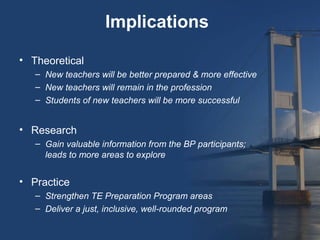This document describes a bridge program created by Western Oregon University's College of Education to support new teachers as they transition from pre-service to in-service educators. It outlines challenges like high teacher attrition rates, discusses strategies like mentoring and communities of practice, and presents preliminary positive findings from the program's first meeting and surveys, including that participants found value in a non-evaluative community, additional professional development, and opportunities for reflection and action.





![Framework:
Community of Practice
It is an aggregate of people who come together around a
mutual engagement. Ways of doing things, ways of
talking, beliefs – in short, practices –[that] emerge in the
course of this mutual endeavor.
- (Eckert & McConnell-Ginet, 1999, p. 464, emphasis added)
Features needed to be considered a CofP.
a) mutual engagement
b) a jointly negotiated enterprise
c) a shared repertoire
- (Wenger, 1998, pp. 76-78).](https://image.slidesharecdn.com/bridgeprogrampresentationforaacte-130129090300-phpapp01/85/Bridge-program-presentation-for-aacte-6-320.jpg)










